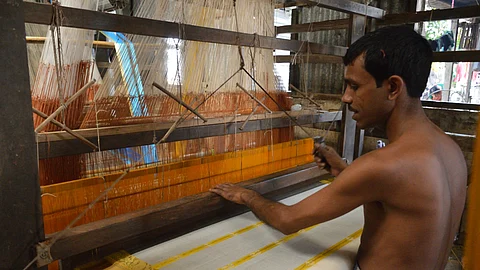
- Destinations
- Experiences
- Stay
- What's new
- Celebrating People
- Responsible Tourism
- CampaignsCampaigns
- SubscribeSubscribe
- Buy Now

The Tant saree, renowned for its impeccable texture, lightness and elaborate motifs, is an unmistakable hallmark of Bengali identity. For the longest time, the Tanti community of West Bengal have remained the custodians of centuries-old tradition which is closely intertwined with the state’s social, economic and cultural fabric. From the riverside settlements of Shantipur and Dhaka to the colonial trade networks of Calcutta, the Tanti weaving tradition has witnessed both resilience and reinvention.
Today, even as mechanisation threatens the handloom industry, Bengal’s weavers continue to craft masterpieces, preserving a legacy that has endured through Mughal patronage, British colonial rule, and the shifts of post-independence India.
The Sanskrit term tantu, which means thread, gives the Tanti community its name, suggesting their longstanding connection to weaving. They were present in Bengal as early as the Gupta era (4th to 6th century CE), according to historical documents. Bengali cotton textiles, especially excellent muslin and jamdani, were well-known around the world by the Mughal Empire. With royal patronage and access to extensive trade networks, Shantipur, Phulia, Dhaka, and Murshidabad became centres of handloom manufacture.
When British colonisation arrived, Bengal's cotton industry took a serious hit. On account of the East India Company's rules, Lancashire-based industrial textiles were preferred over locally woven ones. Nonetheless, Bengal's cotton commerce relied heavily on Calcutta (now Kolkata). Many Tanti weavers had moved to the city by the 19th century, establishing workshops in places like Burrabazar, Shyambazar, and Kumartuli (which is also famous for creating idols) to serve an urban clientele that included Bengali nobility and British officials. In order to accommodate shifting tastes, new inspirations began to merge with traditional Tant designs around this time, causing a shift in weaving patterns.
The fall and continuation of the Tant industry was significantly influenced by Calcutta (now Kolkata). Raw cotton and completed textiles from all over the subcontinent were traded in the city, which developed into a major trading hub. Tant sarees were worn by wealthy Bengali households in Calcutta, and handwoven fabrics, such as Tant, were marketed as representations of native resistance to British authority during the early 20th century Swadeshi movement.
Weavers from East Pakistan (now Bangladesh) migrated to West Bengal during the post-independence era, which contributed to the craft's revival, particularly in places like Phulia. The business was revitalised by the innovative designs, and weaving techniques were brought by these displaced weavers. With Gariahat and Burrabazar acting as important hubs for Tant trade, Calcutta continued to be a vital marketplace.
Tant sarees are chiefly celebrated for their breathability, lightness and intricate motifs, making them particularly well-suited to Bengal’s tropical climate. Cotton threads are carefully cleaned, dried and dyed in a variety of vivid colours to start preparing the yarn for weaving. When the threads are ready, they are placed on the loom in a process called warping and wefting, where the warp forms the lengthwise structure and the weft is interlaced across it.
Designing comes next, when weavers use jacquard looms to produce intricate motifs by using traditional patterns like geometric, floral, and paisley. The most labour-intensive step is weaving, which can generally take many days to finish a single saree, particularly when creating elaborate borders and pallus (the loose end of a saree). Majority of Tant sarees are still made on handlooms, despite technological improvements, guaranteeing the authenticity and craftsmanship of this centuries-old custom.
Tant sarees are renowned for their elaborate patterns, which frequently take cues from regional culture and the natural world. The most common motif is the bhomra, or bumblebee, which represents perseverance and hard work, while the rajmahal, or palace, recalls Bengal's regal past with its exquisite architecture. The hathi (elephant), a motif of strength and wisdom, adds a sense of grandeur, whereas the chandmala (garland of moons) is associated with beauty and celestial harmony. Woven meticulously into the fabric, these patterns not only showcase Bengal’s artistic legacy but also serve as a testament to the weaver’s strong sense of storytelling, preserving cultural narratives through thread and loom.
Despite its enduring appeal, the Tant industry is frequently confronted with threats on its survival. The rise of power looms has led to a flood of machine-made Tant replicas, which, being cheaper, undercut the market for authentic handwoven textiles.
Complementing this issue is the increasingly declining interest among younger generations, who are reluctant to continue in the profession due to low wages and the labour-intensive nature of the craft. While digital platforms have opened up new avenues for sales, many weavers struggle to navigate e-commerce due to a lack of digital literacy, limiting their ability to reach a wider audience.
Furthermore, although government policies exist to support handloom artisans, inconsistent implementation and inadequate financial aid often leave weavers without meaningful assistance. Reviving and sustaining the industry demands a multi-pronged approach—encouraging design innovation, diversifying into home textiles, and investing in targeted skill-development programmes. Ultimately, consumer awareness and a renewed appreciation for handwoven products will play a vital role in ensuring that this centuries-old craft not only endures but thrives in the modern world.
